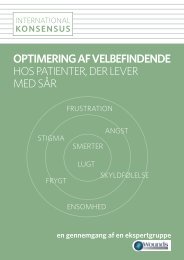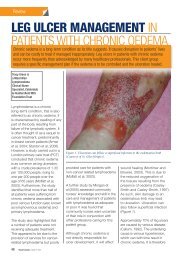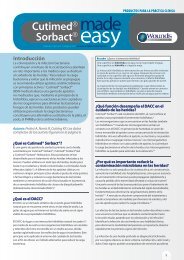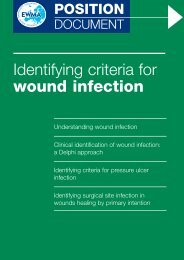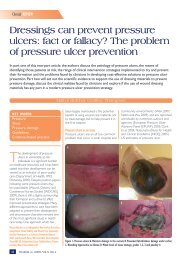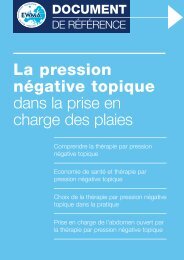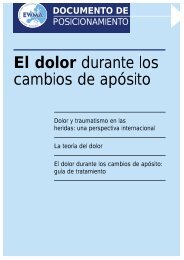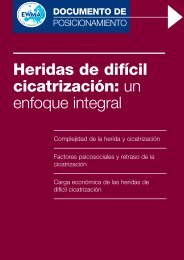DEKUBITUSPROPHYLAXE - Wounds International
DEKUBITUSPROPHYLAXE - Wounds International
DEKUBITUSPROPHYLAXE - Wounds International
Sie wollen auch ein ePaper? Erhöhen Sie die Reichweite Ihrer Titel.
YUMPU macht aus Druck-PDFs automatisch weboptimierte ePaper, die Google liebt.
vorliegen, muss die wirksame und sichere<br />
Verwendung auf der klinischen Einschätzung<br />
beruhen.<br />
LITERATUR<br />
1. Lyder CH. Pressure ulcer prevention and management. JAMA<br />
2003; 289(2): 223-26.<br />
2. National Pressure Ulcer Advisory Panel and European Pressure<br />
Ulcer Advisory Panel. Prevention and treatment of pressure ulcers:<br />
clinical practice guideline. Washington DC: National Pressure<br />
Ulcer Advisory Panel, 2009.<br />
3. European Pressure Ulcer Advisory Panel and National Pressure<br />
Ulcer Advisory Panel. Prevention and treatment of pressure ulcers:<br />
quick reference guide. Washington DC, USA: National Pressure<br />
Ulcer Advisory Panel, 2009. Zugänglich unter: www.npuap.org<br />
and www.epuap.org .<br />
4. Reger SI, Ranganathan VK, Sahgal V. Support surface interface<br />
pressure, microenvironment, and the prevalence of pressure<br />
ulcers: an analysis of the literature. Ostomy Wound Manage<br />
2007; 53(10): 50-8.<br />
5. Reger SI, Ranganathan VK. The importance of the<br />
microenvironment of support surfaces in the prevalence of<br />
pressure ulcers. In: Gefen A (Hrsg.). Bioengineering Research of<br />
Chronic <strong>Wounds</strong> (Studies in Mechanobiology, Tissue Engineering<br />
and Biomaterials): A Multidisciplinary Study Approach. Berlin,<br />
Heidelberg: Springer Verlag, 2009.<br />
6. Roaf R. The causation and prevention of bed sores. J<br />
Tissue Viability 2006; 16(2): 6-8. Reprinted from Bedsore<br />
Biomechanics, McMillan Press, 1976.<br />
7. National Pressure Ulcer Advisory Panel. Support Surface<br />
Standards Initiative. Terms and definitions related to support<br />
surfaces. NPUAP, 2007. Zugänglich unter: http://www.npuap.<br />
org/NPUAP_S3I_TD.pdf.<br />
8. Linder-Ganz E, Gefen A. The effects of pressure and shear on<br />
capillary closure in the microstructure of skeletal muscles. Ann<br />
Biomed Eng 2007; 35(12): 2095-107.<br />
9. Clark M. The aetiology of superficial sacral pressure sores. In:<br />
Leaper D, Cherry G, Dealey C, Lawrence J, Turner T, editors.<br />
Proceedings of the 6th European Conference on Advances in Wound<br />
Management. Amsterdam: McMillan Press; 1996. p. 167-70.<br />
10. Schäfer P, Bewick-Sonntag C, Capri MG, Berardesca E.<br />
Physiological changes in skin barrier function in relation to<br />
occlusion level, exposure time and climatic conditions. Skin<br />
Pharmacol Appl Skin Physiol 2002; 15: 7-19.<br />
11. Bergstrom, N, Braden B, Laguzza A, Holman V. The Braden scale<br />
for predicting pressure sore risk. Nurs Res 1987; 36(4): 205-10.<br />
12. Egawa M, Oguri M, Kuwahara T, Takahashi M. Effect of<br />
exposure of human skin to a dry environment. Skin Res Technol<br />
2002; 8(4): 212-18.<br />
13. Bergstrom N, Braden B. A prospective study of pressure sore<br />
risk among institutionalized elderly. J Am Geriatr Soc 1992;<br />
40(8): 747-758.<br />
14. Nixon J, Brown J, McElvenny D, et al. Prognostic factors<br />
associated with pressure sore development in the immediate<br />
post-operative period. Int J Nurs Stud 2000; 37(4): 279-84.<br />
15. Fisher SV, Szymke TE, Apte SY, Kosiak M. Wheelchair cushion effect<br />
on skin temperature. Arch Phys Med Rehabil 1978; 59(2): 68-72.<br />
16. Brienza DM, Geyer MJ. Using support surfaces to manage<br />
tissue integrity. Adv Skin Wound Care 2005; 18: 151-57.<br />
17. Flam E, Raab L. What is low air loss therapy? European Pressure<br />
Ulcer Advisory Panel, 8th EPUAP Open Meeting. May 2005.<br />
18. Scott EM, Leaper DJ, Clark M, Kelly PJ. Effects of warming<br />
therapy on pressure ulcers-a randomized trial. AORN J 2001;<br />
73(5): 921-38.<br />
19. Knox DM. Core body temperature, skin temperature, and<br />
interface pressure. Relationship to skin integrity in nursing home<br />
residents. Adv Wound Care 1999; 12(5): 246-52.<br />
20. Lachenbruch C. Skin cooling surfaces: estimating the<br />
importance of limiting skin temperature. Ostomy Wound Manage<br />
2005; 51(2): 70-9.<br />
21. Takahashi M, Black J, Dealey C, Gefen A. Pressure in<br />
context. In: <strong>International</strong> review. Pressure ulcer prevention:<br />
pressure, shear, friction and microclimate in context. London:<br />
<strong>Wounds</strong> <strong>International</strong>, 2010. Zugänglich unter: www.<br />
woundsinternational.com/journal.php?contentid=127.<br />
22. Reger SI, Ranganathan VK, Orsted HL, et al. Shear and friction<br />
in context. In: <strong>International</strong> review. Pressure ulcer prevention:<br />
pressure, shear, friction and microclimate in context. London:<br />
<strong>Wounds</strong> <strong>International</strong>, 2010. Zugänglich unter: www.<br />
woundsinternational.com/journal.php?contentid=127.<br />
23. Howell TH. Skin temperature of bedsore areas in the aged. Exper<br />
Gerontol 1981;16(2):137-40.<br />
24. Schubert V, Perbeck L, Schubert PA. Skin microcirculatory and<br />
thermal changes in elderly subjects with early stage of pressure<br />
sores. Clin Physiol 1994;14(1):1-13.<br />
25. Sprigle S, Linden M, McKenna D, et al. Clinical skin temperature<br />
measurement to predict incipient pressure ulcers. Adv Skin<br />
Wound Care 2001; 14(3):133-7.<br />
26. Sae-Sia W, Wipke-Davis DD, Williams DA. Elevated sacral skin<br />
temperature (T(s)): a risk factor for pressure ulcer development<br />
in hospitalized neurologically impaired Thai patients. Appl Nurs<br />
Res 2005; 18(1): 29-35.<br />
27. Rapp MP, Bergstrom N, Padhye NS. Contribution of skin temperature<br />
regularity to the risk of developing pressure ulcers in nursing facility<br />
residents. Adv Skin Wound Care 2009; 22(11): 506-13.<br />
28. Kokate JY, Leland KJ, Held AM, et al. Temperature-modulated<br />
pressure ulcers: a porcine model. Arch Phys Med Rehabil 1995;<br />
76(7): 666-73.<br />
29. Spector WD, Fortinsky RH. Pressure ulcer prevalence in Ohio<br />
nursing homes: clinical and facility correlates. J Aging Health<br />
1998; 10(1): 62-80.<br />
30. Bergquist S, Frantz R. Pressure ulcers in community-based older<br />
adults receiving home health care. Prevalence, incidence, and<br />
associated risk factors. Adv Wound Care 1999; 12(7): 339-51.<br />
31. Schoonhoven,L, Grobbee DE, Donders ART, et al. Prediction of<br />
pressure ulcer development in hospitalized patients: a tool for<br />
risk assessment. Qual Saf Health Care 2006; 15(1): 65-70.<br />
32. Suriadi, Sanada H, Sugama J, et al. Risk factors in the<br />
development of pressure ulcers in an intensive care unit in<br />
Pontianiak, Indonesia. Int Wound J 2007; 4(3): 208-15.<br />
33. Bates-Jensen BM, McCreath HE, Kono A, et al. Subepidermal<br />
moisture predicts erythema and stage 1 pressure ulcers in<br />
nursing home residents: a pilot study. J Am Geriatr Soc 2007; 55:<br />
1199-1205.<br />
34. Mayrovitz HN, Sims N. Biophysical effects of water and synthetic<br />
urine on skin. Adv Skin Wound Care 2001; 14(6): 302-8.<br />
35. Gerhardt LC, Strässle V, Lenz A, et al. Influence of epidermal<br />
hydration on the friction of human skin against textiles. J R Soc<br />
Interface 2008; 5(28):1317-28.<br />
36. Dealey C. Skin care and pressure ulcers. Adv Skin Wound Care<br />
2009; 22(9): 421-28.<br />
37. Panel on the Prediction and Prevention of Pressure Ulcers in<br />
Adults. Pressure Ulcers in Adults: Prediction and Prevention: Clinical<br />
Practice Guideline Number 3. AHCPR Publication No.92-0047.<br />
Rockville, MD: Agency for Health Care Policy and Research,<br />
Public Health Service, U.S. Department of Health and Human<br />
Services. May 1992.<br />
38. Zhong W, Xing MM, Pan N, Maibach HI. Textiles and human<br />
skin, microclimate, cutaneous reactions: an overview. Cutan Ocul<br />
Toxicol 2006; 25(1): 23-39.<br />
39. Bale S, Tebble N, Jones V, Price P. The benefits of implementing<br />
a new skin care protocol in nursing homes. J Tissue Viability<br />
2004; 14(2): 44-50.<br />
40. Ferrarin M, Ludwig N. Analysis of thermal properties of<br />
wheelchair cushions with thermography. Med Biol Eng Comput<br />
2000; 38(1): 31-34.<br />
41. West J, Hopf H, Szaflarski N, et al. The effects of a unique<br />
alternating-pressure mattress on tissue perfusion and<br />
temperature. In: 5th Annual meeting of the European Tissue Repair<br />
Society. Padua, ETRS: 1995.<br />
42. Reger SI, Adams TC, Maklebust JA, Sahgal V. Validation test<br />
for climate control on air-loss supports. Arch Phys Med Rehabil<br />
2001; 82(5): 597-603.<br />
43. Flam E, Isayeva E, Kipervas Y, et al. Skin temperature and<br />
moisture management with a low air loss surface. Ostomy<br />
Wound Manage 1995: 41(9):5 0–56.<br />
44. McNabb LJ, Hyatt J. Effect of an air-fluidized bed on insensible<br />
water loss. Crit Care Med 1987; 15(2): 161-62.<br />
45. Williamson R. Impact of linen layers to interface pressure and<br />
skin microclimate. Poster at NPUAP 11th Biennial Conference,<br />
2009.<br />
46. Cullum N, Deeks J, Sheldon TA, et al. Beds, mattresses and<br />
cushions for pressure sore prevention and treatment. Cochrane<br />
Databease Syst Rev 2000; (2): CD001735.<br />
47. Inman KJ, Sibbald WJ, Rutledge FS, Clark BJ. Clinical utility and<br />
cost-effectiveness of an air suspension bed in the prevention of<br />
pressure ulcers. JAMA 1993; 269(9): 1139-43.<br />
DRUCK, SCHERKRÄFTE, REIBUNG UND MIKROKLIMA IM KONTEXT | 25




